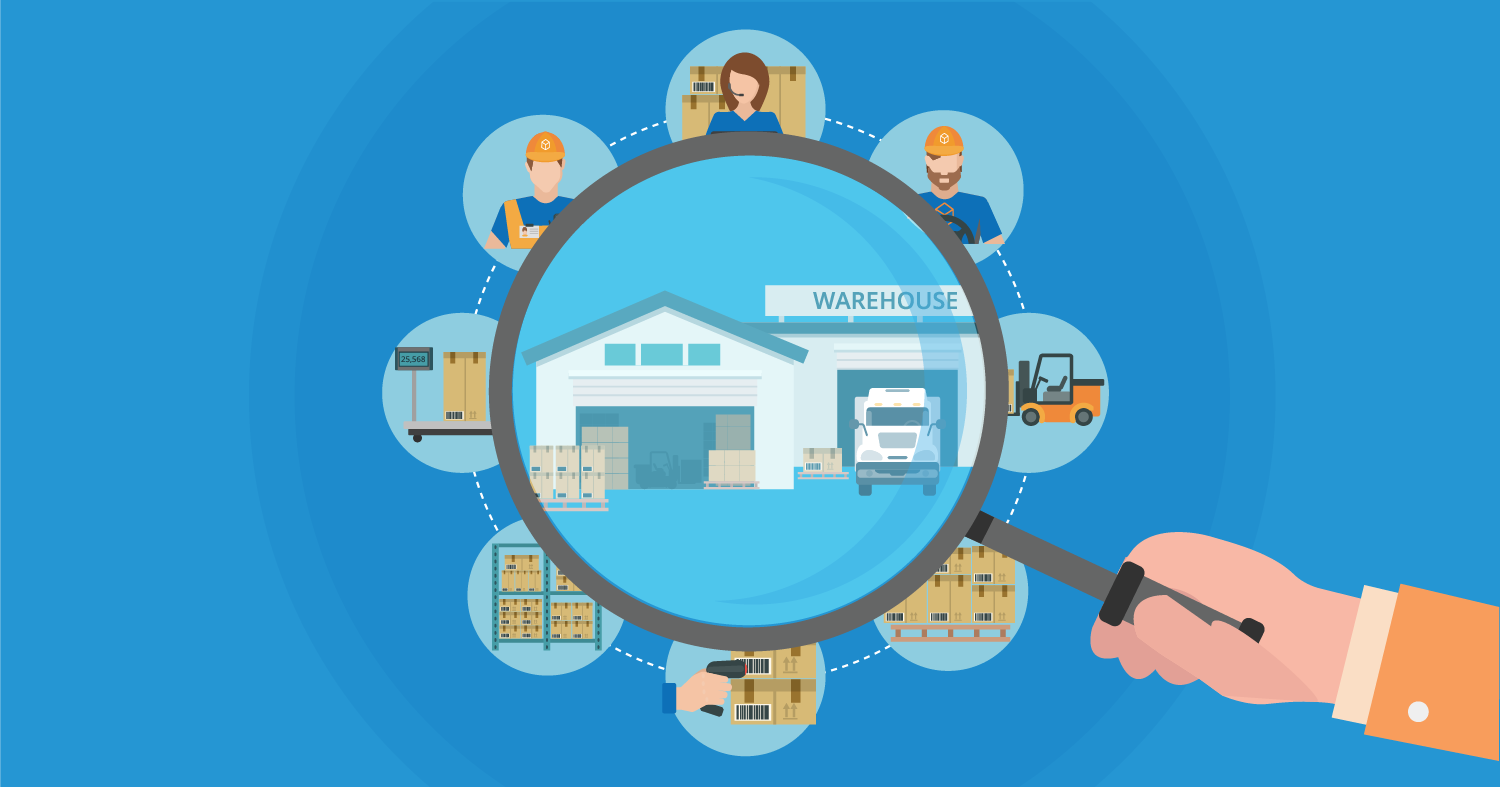Posted on: July 7, 2021
Enable Workforce Monitoring Software to Improve Warehouse’s Back-Office Efficiency
Get started
Measuring how employees perform and dealing with everyday workflow is the need of the hour. Workforce monitoring software helps in facilitating employee productivity in today’s business landscape. Effective warehouse management is the key to offering quick service deliveries and distribution of goods without delays. It covers 24*7 back-office and on-premise operations that go from receiving, identifying, and storing goods to packaging, marking, weighing, and delivering products to customers.
From order pickup drivers to delivery executives and to check employee efficiency and productivity, warehouse operations need constant tracking and support availability. However, only receiving and delivering goods and stocks is not enough!
Table of contents
Some Basic Warehouse Operations Fields that Require Your Constant Attention
Businesses in the supply chain cannot compromise with inventory storage capabilities, order management, and workers’ roles. The faster and more seamless the processes are, the sooner the inventory will become easy to maintain. Some of the basic elements in balancing and managing back-office operations can include:
- Recorded all information on newly received inventory and assigned roles to employees to maintain it.
- Managing employee hours and keeping tabs on per worker’s items responsibility
- Detecting the unpackaged, disorganized items and making a record of them.
- Putting away the labeled items and segregate them accordingly to file them in records,
- Keeping vendor data in check and securing crucial data from cyber threats and inventory information leakage.
- Updating inventory records to check the latest stock levels and orders, respectively.
This continuous operational chain used to have limited resources to get in control of the inventory time tracking. Traditionally, bundles of papers and bulk files were the only options for record-keeping purposes. As technology has taken over the usual workflow of business operations in every industry, organizations are looking for solutions to keep regular operations intact.
Today’s technologies activate seamless workflow and help make massive data precise and easy to decode. Various tools are available to improve the workforce performance of your back-office operations. Investing in the right technology, from warehouse management systems to workforce monitoring software, can help you streamline your warehouse processes efficiently.
It is important to seek what works best for you, especially in times like today, when things are uncertain, and businesses have to push their boundaries without putting too many resources out there. There are no centralized work criteria in warehouse operations. Rather, it is so diversified that employees must be accountable for their work, whether on-premises or handling back-office.
Moving forward, let’s talk about what are the factors that can affect a warehouse’s back-office operations and how your business can overcome such situations.
Concerns that can be a Hindrance to Streamlining your Warehouse Back-Office Operations
The sudden spread of the pandemic affected warehousing demand because of the lockdown and reduced manufacturing activities. Where some of the daily activities had to suffer, back-office operations strengthened the warehousing industry by shifting consumer preference from offline to online. After bearing lockdown consequences, many businesses are returning on track. We cannot ignore the fact that today’s business landscape demands to thrive in a hybrid work culture. Organizations have realized the many benefits that remote work can offer in the long term.
If the warehouse’s back-office operations are not in order, it becomes impossible to serve customers seamlessly, manage vendors, and handle workers. It might seem easy to plan, but it becomes difficult to execute. For instance, you cannot improve something without an in-depth analysis of the bottlenecks and gaps. Thus, it is vital to fetch details if you want to utilize your resources to the fullest.
Any obstacle within the chain can impact the entire process negatively. Businesses in the warehouse industry require such tools for remote workforce management to monitor and review inefficiencies actively. If not managed correctly, warehouse operations can run into plenty of issues. Thus, businesses must identify the disjointed teams and redundant processes to save them from poor management and disorganized back-office operations.
Let us highlight potential back-office operational hindrances and how you can overcome them with workforce monitoring software while improving employee efficiency.
Ineffective Task Management
From warehouse supervisors to pickers on the floor, ineffective task management in every role needs to be monitored. Accountability becomes crucial while assigning tasks to own the inventory and manage records related to receiving and delivering the items. Who takes care of inventory, what time is allotted to a specific worker or supervisor, and which shift that work gets the job done? Tracking this can help businesses to identify delays and unproductive workers who did not perform the tasks correctly.
Solution
What is better than having visibility into every worker’s task performance? Automating the calculation of average processing times an employee used to perform the task. Moreover, in the present remote work culture, virtually scheduling tasks and assigning roles make back-office workflow much easier. Get complete visibility into employee performances, real-time web activity, and backlogs with employee monitoring software. Optimize task assignments in a jiffy for workers who switch between front and back-office operations.
Inventory Mismanagement – Theft and Data Losses
Inventory management needs a lot of security measures that bring forth round-the-clock tracking. For each stage of the inventory management process, you need to include teams, including managers and front-line staff. Here, staff-buy becomes crucial where you have to control assigning the right people for the job. The reason behind being cautious is to not rely on every worker who can take advantage by leaking important information or a less experienced one who can get under the trap of cyber-attack.
Solution
Inventory management requires effective planning. Make strategies continually and keep updating plans regarding inventory management. Too many documents and files that hold the vital information of inventory assets need to be monitored constantly. So, no employee can take advantage of it by stealing anything from inventory. Having records will be useful and by tracking the employee productivity, you can manage workers and inventory items in a better way.
Employee Downtime and Lack of Productivity
Business leaders know the value of productivity at work when they are bearing costs to get things done. How can your business keep tabs on employee productivity tracking if your warehouse is in another location or your back office employees are working remotely? How do employees work and behave when there is no supervisor around? It begins with gaining transparency into how they work and the time they put in each day. Revealing task objectives and achieving performance data can help you streamline further processes. So, how can you do this in today’s remote work era?
Solution
With workforce monitoring software, managers can improve agent performance. When you get insights into work adherence per shift and scheduled tasks, you can measure employee efficiency in tackling tasks. Improve and forecast task accuracy by understanding through behavioral analysis and visibility into actual work activities. Even the most effective technologies cannot help if employees do not understand the criteria behind them. Thus, be transparent and open with employees about monitoring.
Consider Automation (Employee Monitoring Software)
Does your organization capture and manage crucial KPIs of your regular operations? Do you know how your employees’ critical productivity can impact everyday operations, specifically in an industry like warehouses? Measure the everyday productivity of your employees with workforce monitoring software that can bring out quick results and metrics. It will show you workforce productivity data as employee analytics and help you implement better communication with workers.
An efficient employee monitoring software will help you scrutinize employee performance tracking and amplify the feedback culture between leaders and workers. Identify task accuracy issues, notify employees of performance errors, and give them instant real-time alerts on urgent information. Warehouse operations and back-office support will become seamless when all teams keep things in order daily.
Include a maintenance plan beforehand to track how many deliveries a worker does or how many hours per worker takes in inventory management. By measuring per order and shift, it becomes easy for supervisors to assign tasks accordingly.
Takeaway
Businesses in the warehouse industry should act according to the era of remote work and save time on daily operations. Back-office efficiency is not easy to achieve, and maintaining inventory and bulky reports is quite a hard task if not done properly. Workforce monitoring software simplifies these difficulties for you and makes your daily workflow more convenient. Make your KPIs clear and set guidelines for employees.
Time tracking tool provides insights from a centralized dashboard representing real-time visibility into employees’ work through periodic screenshots. It enhances collaboration and communication between supervisors and workers as well. Therefore, if you are looking for solutions that help you achieve better employee efficiency and back-office productivity results, the workforce monitoring software will greatly help.







